句子成分及种类
句子成分的种类与基本搭配规则
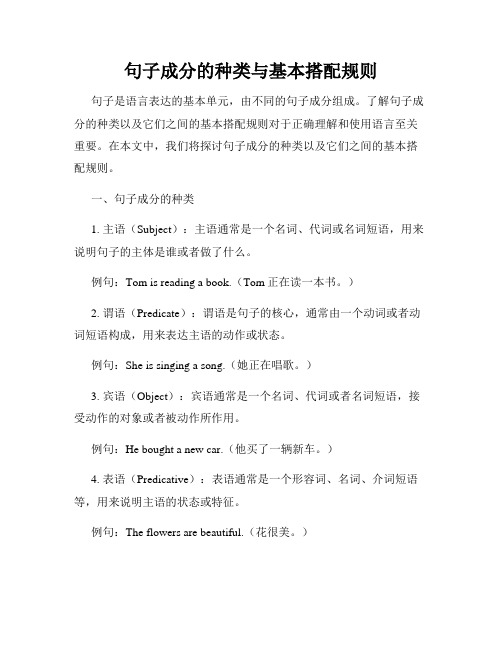
句子成分的种类与基本搭配规则句子是语言表达的基本单元,由不同的句子成分组成。
了解句子成分的种类以及它们之间的基本搭配规则对于正确理解和使用语言至关重要。
在本文中,我们将探讨句子成分的种类以及它们之间的基本搭配规则。
一、句子成分的种类1. 主语(Subject):主语通常是一个名词、代词或名词短语,用来说明句子的主体是谁或者做了什么。
例句:Tom is reading a book.(Tom正在读一本书。
)2. 谓语(Predicate):谓语是句子的核心,通常由一个动词或者动词短语构成,用来表达主语的动作或状态。
例句:She is singing a song.(她正在唱歌。
)3. 宾语(Object):宾语通常是一个名词、代词或者名词短语,接受动作的对象或者被动作所作用。
例句:He bought a new car.(他买了一辆新车。
)4. 表语(Predicative):表语通常是一个形容词、名词、介词短语等,用来说明主语的状态或特征。
例句:The flowers are beautiful.(花很美。
)5. 定语(Attributive):定语通常是一个形容词、名词、代词或者名词短语,用来修饰名词。
例句:I like the red dress.(我喜欢那件红色的连衣裙。
)6. 状语(Adverbial):状语通常是一个副词、介词短语、动词不定式短语等,用来修饰动词、形容词、副词等,并表达时间、地点、原因、方式等其他信息。
例句:They went to the park yesterday.(他们昨天去了公园。
)7. 补语(Complement):补语通常是一个形容词、名词、介词短语等,用来补充说明主语或宾语的特征。
例句:He became a doctor.(他成为一名医生。
)二、句子成分的基本搭配规则1. 主语和谓语:主语和谓语构成句子的核心部分,主语一般在谓语之前。
例句:The boy is playing in the park.(男孩在公园里玩。
句子成分的种类

句子成分的种类在语法学中,句子是语言表达思想的基本单位。
句子成分则是构成句子的各个组成部分,它们在句子中扮演不同的角色。
从功能上来看,句子成分可以分为主语、谓语、宾语、定语、状语和补语等几个类别。
1. 主语主语一般是句子中执行动作或者是被动接受动作的实体。
例如:- 小明(名词)写了一篇长篇小说。
- 她(代词)是一位优秀的画家。
- 我们班(名词短语)有三十个学生。
2. 谓语谓语是句子中用来说明主语动作、状态或者存在的部分。
谓语包括动词和谓语补足语。
例如:- 我们(主语)昨天去了电影院(谓语动词)。
- 他(主语)是一名医生(谓语补足语)。
3. 宾语宾语是句子中接受动作的实体,它通常是谓语动词所作用的对象。
例如:- 我喜欢看电影。
这里的“电影”就是宾语。
- 她听到了好消息。
这里的“好消息”是宾语。
4. 定语定语是用来修饰名词或者代词的成分,它可以限制名词的范围或者提供更多的描述信息。
例如:- 那个高大的男孩正在踢足球。
这里的“高大的”就是定语。
- 这是我买的新书。
其中,“我买的”是定语,修饰了“新书”。
5. 状语状语是用来修饰动词、形容词、副词和全句的成分。
它可以表示时间、地点、原因、方式等。
例如:- 他慢慢地走进了教室。
这里的“慢慢地”是状语,表示方式。
- 昨天,我在图书馆看书。
这里的“昨天”是状语,表示时间。
6. 补语补语通常用来补充说明主语或宾语的状态、性质或属性。
补语可以是形容词、名词、副词或者介词短语。
例如:- 他是一位很优秀的运动员。
这里的“很优秀”的“很”是补语。
- 我觉得你很漂亮。
这里的“漂亮”是补语。
以上是句子成分的六大类别,它们在句子中发挥不同的作用。
熟练掌握各类句子成分的用法,有助于准确表达意思,使文章更加通顺和自然。
当然,句子成分的种类还有其他的细化和变化,但以上介绍的是基本的分类,对于初学者来说已经足够了。
希望这篇文章对你的学习有所帮助!。
九大成分,基本句子类型

句法1、九大句子成分:一、主语(Subject):表示句子说的是什么人或什么事。
1. During the 1990s, American country music has become more and more popular.2. We often speak English in class.3. To swim in the river is a great pleasure.4. Smoking does harm to the health.5. When we are going to have an English test has not been decided.6. It is necessary to master a foreign language.二、谓语(Predicate):说明主语所做的动作或具有的特征和状态。
动词在句中作谓语,一般放在主语之后。
1. He practices running every morning.2. The plane took off at ten o’clock.3. Do you speak English?4. They are working in a field.5. He has caught a bad cold.三、表语(Predicative):用以说明主语的性质、特征、状态与身份,它一般位于系动词之后。
系动词:1)状态系动词用来表示主语状态,只有be一词,例如:He is a teacher.2)持续系动词用来表示主语继续或保持一种状况或态度,主要有keep, remain, stay, lie, stand, 例如:He always kept silent at meeting.3)感官系动词主要有feel, smell, sound, taste, 例如:This kind of cloth feels very soft.4)变化系动词表示主语变成什么样,主要有become, grow, turn, fall, get, go, come, run.例如:The river was beginning to run dry.1. Our teacher of English is an American.2. It sounds good.3. The weather has turned cold.4. Your dreams come true.5. He became a good doctor.四、宾语(Object):表示动作的对象或承爱者,一般位于及物动词和介词后面。
句子成分的种类与功能总结

句子成分的种类与功能总结在语言学中,句子是最基本的语言单位,由不同的句子成分组成。
这些句子成分在句子中扮演着不同的角色,有着各自独特的功能。
通过对句子成分的分类和功能的总结,我们可以更好地理解句子的结构和意义。
一、名词性成分1. 主语:句子的主题,通常是由名词、代词或名词短语作为其核心。
2. 谓语:句子的核心,表示主语的动作、状态或属性。
可以是及物动词、不及物动词、连系动词等。
3. 宾语:接在及物动词后面,表示动作的承受者或作用对象。
通常是名词或代词。
4. 补语:补充说明主语或宾语的属性、状态或特征。
可以是形容词、名词、动词不定式、副词等。
二、状语1. 地点状语:表示动作发生的地点或范围。
2. 时间状语:表示动作发生的时间或时间段。
3. 方式状语:表示动作的方式、方式或手段。
4. 原因状语:表示动作的原因或理由。
5. 目的状语:表示动作的目的或意图。
6. 结果状语:表示动作的结果或后果。
7. 条件状语:表示动作发生的条件。
8. 比较状语:表示动作的程度、程度或大小的比较。
三、定语1. 形容词:修饰名词或代词,表示其属性、性质或特征。
2. 限定词:修饰名词,确定其数量、身份或范围。
例如:数词、冠词、指示代词等。
3. 关系词:引导定语从句,修饰名词,进一步说明其身份、特点或关系。
四、独立成分1. 独立主格:由名词(或代词)和非谓语动词(一般是现在分词或过去分词形式)构成,表示与主句中的主语或宾语并行的另一动作或情况。
2. 独立结构:包括独立主格、独立句和独立分句。
可以独立存在,不影响主句的结构和意义。
五、补充成分1. 插入语:用于在句子中插入补充、解释或陈述附加信息。
一般用逗号、括号或破折号包围。
2. 状语从句:由连词引导的从句,用来修饰句子中的动词、形容词或副词。
3. 定语从句:由关系代词或关系副词引导的从句,用来修饰名词或代词。
综上所述,句子成分的种类与功能多种多样,每个成分都在句子中扮演着不可或缺的角色。
句子成分和句子种类

4. There ______ two pictures and a map of China on the wall.
A. are B. has C. have D. is
5. Neither he nor I _______ going to the park. A. be B. is C. are D. am
What _d__id__ Ann ___d_o__ last year?
c. 常见疑问词(组):what, what+名词 (如: what colour, what grade等), when, why, where,who (whom), which, whose, how, how+形容词/ 副词 (如: how long, how far, how often, how soon 等)。要注意以上各种疑问词(组)的用法。
(二)突破方法 1、掌握陈述句的肯定式、否定式和除no, not以外的
表示否定意义的词。 2、注意疑问词的意思和用法,重点掌握反意疑问句。 3、掌握否定祈使句,let开头的祈使句,加强语气的
祈使句。 4、掌握what和how引导的感叹句和一些特殊形式。
【知识清单】 初中生需要掌握的句子种类
肯定句 1、陈述句
[例1] They had lots of friends in China.
They _d_id_n_’_t have _m__a_n_y_ friends in China.
[例2] I could dance and sing when I was five
years old.
I _c_o_u_l_d_n_’t_ dance ___o_r__ sing when I was
句子成分和种类
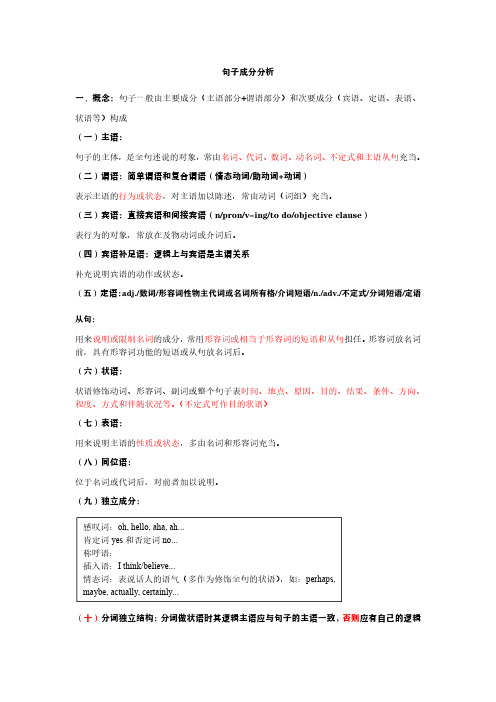
句子成分分析一、概念:句子一般由主要成分(主语部分+谓语部分)和次要成分(宾语、定语、表语、状语等)构成(一)主语:句子的主体,是全句述说的对象,常由名词、代词、数词、动名词、不定式和主语从句充当。
(二)谓语:简单谓语和复合谓语(情态动词/助动词+动词)表示主语的行为或状态,对主语加以陈述,常由动词(词组)充当。
(三)宾语:直接宾语和间接宾语(n/pron/v-ing/to do/objective clause)表行为的对象,常放在及物动词或介词后。
(四)宾语补足语:逻辑上与宾语是主谓关系补充说明宾语的动作或状态。
(五)定语:adj./数词/形容词性物主代词或名词所有格/介词短语/n./adv./不定式/分词短语/定语从句:用来说明或限制名词的成分,常用形容词或相当于形容词的短语和从句担任。
形容词放名词前,具有形容词功能的短语或从句放名词后。
(六)状语:状语修饰动词、形容词、副词或整个句子表时间、地点、原因、目的、结果、条件、方向、程度、方式和伴随状况等。
(不定式可作目的状语)(七)表语:用来说明主语的性质或状态,多由名词和形容词充当。
(八)同位语:位于名词或代词后,对前者加以说明。
(九)独立成分:感叹词:oh,hello,aha,ah...肯定词yes和否定词no...称呼语:插入语:I think/believe...情态词:表说话人的语气(多作为修饰全句的状语),如:perhaps,maybe,actually,certainly...(十)分词独立结构:分词做状语时其逻辑主语应与句子的主语一致,否则应有自己的逻辑主语,构成分词独立结构1、2、二、五种基本句型(一)S+V(vi.)(二)S+V+P(predicative):句子的谓语动词不能表达一个完整的意思,必须加上一个表明主语身份或状态的表语构成复合谓语,才能表达完整的意思。
这类动词叫连系动词(三)S+V(vt.)+O(四)S+V(vt.)+o(间宾)+O(直宾)(五)S+V(vt.)+O+OC三、按句子结构分:(一)简单句:只有一个主语(并列主语)和谓语(并列谓语),即只有一个主谓结构(二)并列句:简单句+并列连词+简单句(相互之间是平行并列的关系)1、2、连接两个同等概念:and,not only...but also...,neither...nor...,then等(or表并列的时候,用于否定句)表选择的连词:or,otherwise,either...or...等名词/代词宾格+名词:The war made him a soldier.+形容词:New methods make the job easy.+介词短语:I often find him at work.+动词不定式:The teacher ask the students to close the windows. +分词:I saw a cat running across the road.Studying hard,you can make your score go up.If you study hard,your score will go up.分词独立结构常省略being,having been...,但在there being句型中不能省:Game(being)over,he went home.He stands there,book(being)in hand.With nothing to do,he fell asleep soon.The teacher came in,with glass on his nose.3、4、(三)复合句:含有一个或一个以上的从句(名从、状从、定从)四、按句子用途分:(一)陈述句:肯定句和否定句陈述一个看法或说明一个事实,主语在前,谓语在后注:把肯定句改为否定句时,有以下两原则:1、be 动词、助动词have/has 、或情态动词can,may,must,will,shall...+not2、实义动词和行为动词变否定,需根据时态和人称来选择don’t/doesn’t/didn’t(二)疑问句:1、一般疑问句(general questions):一提二改三问号把情态动词、系动词和助动词提前,用来询问一件事,回答用yes/no2、特殊疑问句(special questions):疑问词+一般疑问句疑问词:who/what/when/how/which/why/where/whose/how...3、选择疑问句(alternative questions):不能用yes/no 来回答结构多为:(1)一般疑问句+or+省略的一般疑问句(2)用疑问词which、whose 等提问4、反义疑问句(tag/disjunctive questions):陈述句+简略疑问句(1)陈述部分含有seldom/hardly/never/few/nothing 等否定词或半否定词,其疑问部分要用肯式(含有否定前缀还是用否定式)(2)疑问部分的主语与陈述部分保持一致,且主语必须是代词(3)陈述部分含“have”表转折的连词:but,yet,while 等表因果的连词:so,for 等①There be 句型中,疑问部分的主语仍用there②陈述部分的主语为指示代词和something/anything/nothing/everything 等复合不定代词时,疑问部分的主语用it 或they③陈述部分的主语为someone/anyone/everyone/no one/everybody 等复合不定代词时,疑问部分的主语在正式文体中用he ,在口语中可用they①当have 为助动词时,就用have②当have 表“所有”时,可以用have 或do③当have 表“吃,喝”时,用do④用于have to 时,表经常性行为,用do ;若表特定的行为,用have(4)陈述部分含情态动词时,通常直接用该情态动词提问。
句子的句式有哪些种类和类型
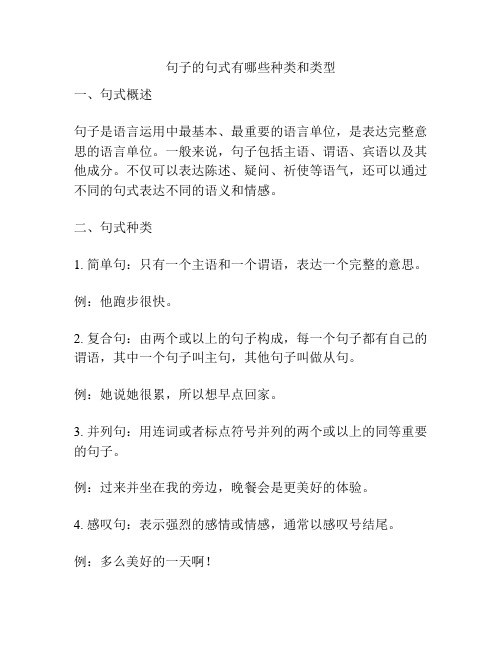
句子的句式有哪些种类和类型一、句式概述句子是语言运用中最基本、最重要的语言单位,是表达完整意思的语言单位。
一般来说,句子包括主语、谓语、宾语以及其他成分。
不仅可以表达陈述、疑问、祈使等语气,还可以通过不同的句式表达不同的语义和情感。
二、句式种类1. 简单句:只有一个主语和一个谓语,表达一个完整的意思。
例:他跑步很快。
2. 复合句:由两个或以上的句子构成,每一个句子都有自己的谓语,其中一个句子叫主句,其他句子叫做从句。
例:她说她很累,所以想早点回家。
3. 并列句:用连词或者标点符号并列的两个或以上的同等重要的句子。
例:过来并坐在我的旁边,晚餐会是更美好的体验。
4. 感叹句:表示强烈的感情或情感,通常以感叹号结尾。
例:多么美好的一天啊!5. 祈使句:表示请求、命令、劝告等,通常以动词原形开头。
例:把书拿给我。
三、句式类型1. 简单句类型断言句、疑问句、祈使句2. 复合句类型主从句类型、并列句类型、间接引语类型3. 平衡句类型对偶句、三段论句、反问句4. 比较句类型比喻句、拟人句、对比句5. 描述句类型描绘句、夸张句、概括句四、句式分析句子分析是语言学分析的一个分支,在文学、语言学市场中都有重要的作用。
可以从以下几个方面对句式进行分析:1. 句子成分分析句子成分包括主语、宾语、谓语、定语、状语、补语等。
分析句子成分可以帮助我们更好地理解句子的意义。
2. 句子结构分析句子结构分析指的是句子在语法上的结构形式,包括并列句、复合句、长句等。
分析句子结构有助于我们了解句子在语言中的功能和作用。
3. 句子语调分析句子语调分析指的是句子在语音上的声调和节奏。
分析句子语调可以帮助我们更好地理解句子的语感和情感。
4. 句子语言层次分析句子语言层次分析指的是句子在语言上的形式美感和文化内涵。
分析句子语言层次可以帮助我们更好地欣赏和理解作品中的语言表达。
五、小结句式是语言表达中重要的组成部分,包括简单句、复合句、并列句、感叹句、祈使句等不同的种类和类型。
句子成分的种类及其在句子中的作用

句子成分的种类及其在句子中的作用句子是语言表达的基本单位,由一个或多个词语组成,表达完整的意思。
在句子中,各单词承担不同的角色和功能,被称为句子成分。
本文将介绍句子成分的种类及其在句子中的作用。
一、句子成分的基本种类1.主语(Subject):主语是句子中扮演动作的发出者或者是状态的具体承受者的成分。
主语通常由名词、代词、动名词、不定式等构成,它在句子中起名、代词、动名词、不定式等作用,并且与谓语动词构成句子的主谓结构。
例句:Tom is a student.(汤姆是一个学生。
)2.谓语(Predicate):谓语是句子中表示主语所表示的状态或动作的成分。
谓语通常由动词构成,它在句子中起断定、判断、说明、叙述、指示等作用,并且与主语构成句子的主谓结构。
例句:I like playing football.(我喜欢踢足球。
)3.宾语(Object):宾语是句子中接受动作的对象或者是动作的受益者的成分。
宾语通常由名词、代词、动名词、不定式等构成,它在句子中起受动、补充、限定等作用,并且与及物动词构成句子的动宾结构。
例句:She bought a book.(她买了一本书。
)4.定语(Attributive):定语是句子中修饰名词或代词的成分。
定语通常由形容词、形容词性物主代词、数词、限定性定语从句等构成,它在句子中起描绘、修饰、区分等作用,并且与被修饰词构成定语短语或被修饰词+定语从句的结构。
例句:The blue car is mine.(那辆蓝色的车是我的。
)5.状语(Adverbial):状语是句子中表示时间、地点、原因、目的、方式、程度、结果等的成分。
状语通常由副词、介词短语、动词不定式短语、动名词短语、副词从句等构成,它在句子中起状况、修饰、限定、补充等作用,并且与主句构成状语从句或者状语短语的结构。
例句:He went to the park yesterday.(他昨天去了公园。
)6.补语(Complement):补语是句子中修饰主语、宾语、定语的成分。
高中英语句子成分和句子种类

高中英语句子成分和句子种类
在高中英语中,句子的成分主要包括主语、谓语、宾语、表语、定语、状语和补语。
以下是常见句子种类和其成分的示例:
1.简单句:只包含一个主语和一个谓语。
- 主语 + 谓语:She runs every morning.(主语为She,谓语为runs)
2.并列句:由两个或多个简单句通过连词连接而成。
- 简单句 + 连词 + 简单句:She studies hard, but she still gets low grades.(第一个简单句的主语为She,谓语为studies,第二
个简单句的主语为she,谓语为gets)
3.复合句:包含一个主句和一个或多个从句。
- 主句 + 从句:I will go to the park if it doesn't rain.(主
句的主语为I,谓语为will go;从句的主语为it,谓语为doesn't rain)
4.疑问句:用于提问,通常以动词开头。
- 动词 + 主语 + 其他成分:Do you like ice cream?(动词为Do,主语为you)
5.祈使句:用于发出命令、请求、建议等,通常省略了主语。
- 谓语 + 其他成分:Close the door, please.(谓语为Close)
6.感叹句:表示强烈的情感或感叹,通常以感叹词开头。
- 感叹词 + 主句:What a beautiful sunset!(感叹词为What)
这些只是常见的句子种类和示例,实际上还有其他不同类型的句子,具体的情况需要根据语境和句子的用途来判断。
中学语文句子成分划分知识

⑺鲁迅先生的第一个特点是他的政治远见。 (鲁迅先生)的(第一个)特点‖是(他)的
(政治)远见。
⑻ 最近北京人民广播电台还播放了阿隆·阿甫 夏洛穆夫以北京胡同为题的交响诗。
〔最近〕北京人民广播电台|〔还〕播放了( 阿隆·阿甫夏洛穆夫)(以北京胡同为题的) 交响诗。
⑼两只美丽的画眉高兴地唱一首歌。
B.这对于一班见异思迁的人,对于一班鄙薄技术 工作以为不足道、无出路的人,也是一个极好的 教训。 主干:这是极好的教训。
C.我过生日时,父母送了我一套科学书籍。 主干:父母送我书籍。
D.改革开放以后,城乡人民的生活一天比一天好 起来。 主干:生活好起来。
(A:海燕飞翔 B:这是教训 D:生活好)
10.根据句意用双竖线划开主、谓语正确的 是( D ) A.他‖写的有名的《正气歌》歌颂了古代 有骨气的人的英雄气概。
+动词+补语”,口语中常用“叫”“让”“给”来代 替“被”。
几种特殊的单句
▪ 连动句是用连动短语充当谓语的句子。两个动词, 互不作成分,而是共同作谓语,但在语义上有目 的和方式、原因和结果、先和后的关系。因此短 语的位置顺序不能相互颠倒,中间也没有语音停 顿。例如: ⑴ 他搜集着一片片的干苔藓烧水喝。(目的) ⑵ 凭着他的求生的意志,他还是挣扎着蠕动爬行。 (方式) ⑶ 由于长期的劳累过度,李老师终于生病住院了。 (因果)
宾语
▪ 宾语:在动词后面,表示动作、行为所涉 及的人或事物,回答“谁”或“什么”一 类问题。
▪ 例:什么叫做信息? 门口围着一群看热闹的。 大家认为他很有勇气。 他是学生。 我们拥有青春。
(能做主语的一般都能做宾语)
定语
▪ 定语:在句子中起着修饰、限制主语或宾 语中心语的作用。
八种句子成分
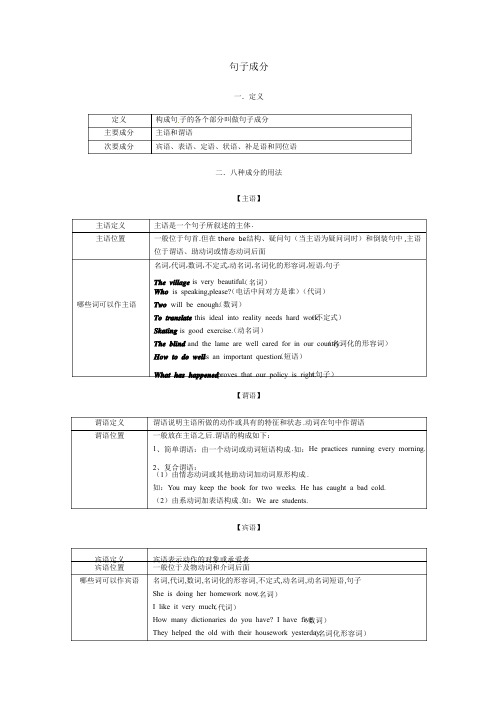
定义定义构成句子的各个部分叫做句子成分子的各个部分叫做句子成分 主要成分主要成分主语和谓语主语和谓语 次要成分次要成分宾语、表语、定语、状语、补足语和同位语 主语定义主语定义主语是一个句子所叙述的主体. 主语位置主语位置 一般位于句首.但在there be 结构、疑问句(当主语为疑问词时)和倒装句中,主语位于谓语、助动词或情态动词后面哪些词可以作主语哪些词可以作主语 名词,代词,数词,不定式,动名词,名词化的形容词,短语,句子句子 The village is very beautiful.(名词)(名词) Who is speaking,please?(电话中问对方是谁)(电话中问对方是谁)(代词)(代词) Two will be enough.(数词)(数词)To translate this ideal into reality needs hard work.(不定式)(不定式)Skating is good exercise.(动名词)(动名词)The blind and the lame are well cared for in our country.(名词化的形容词)(名词化的形容词)How to do well is an important question.(短语)(短语)What has happened proves that our policy is right.(句子)(句子)谓语定义谓语定义谓语说明主语所做的动作或具有的特征和状态.动词在句中作谓语动词在句中作谓语 谓语位置谓语位置 一般放在主语之后.谓语的构成如下:谓语的构成如下:1、简单谓语:由一个动词或动词短语构成.如:He practices running every morning. 2、复合谓语:、复合谓语: (1)由情态动词或其他助动词加动词原形构成. 如:You may keep the book for two weeks. He has caught a bad cold. (2)由系动词加表语构成.如:We are students. 宾语定义宾语定义宾语表示动作的对象或承爱者 宾语位置宾语位置一般位于及物动词和介词后面 哪些词可以作宾语哪些词可以作宾语 名词,代词,数词,名词化的形容词,不定式,动名词,动名词短语,句子句子She is doing her homework now.(名词)(名词)I like it very much.(代词)(代词)How many dictionaries do you have? I have five.(数词)(数词)They helped the old with their housework yesterday.(名词化形容词)(名词化形容词)He likes to play basketball.(不定式)(不定式)I like swimming.(动名词)(动名词)We enjoy listening to the music.(动名词短语)(动名词短语)He told me that he was a teacher before.(句子)(句子)宾语种类宾语种类 (1)双宾语(间接宾语+直接宾语)例如:Lend me your dictionary, please. (2)复合宾语(宾语+宾补)例如:They elected him their monitor. 【定语】【定语】定语定义定语定义修饰名词或代词的词、短语或从句称为定语 定语位置定语位置被修饰的词前或后被修饰的词前或后 哪些词可以作定语哪些词可以作定语 名词,代词,名词或代词所有格,数词,形容词(限观形龄色国材),分词,动名词,不定式,介词短语,句子可以作定语. Guilin is a beautiful city.(形容词)(形容词)China is a developing country; America is a developed country.(分词)(分词)There are thirty women teachers is our school.(名词)(名词)His rapid progress in English made us surprised.(代词)(代词)His son needs Tom ’s pen.(代词和名词所有格)(代词和名词所有格)(代词和名词所有格) Two boys need two pens.(数词)(数词)Our monitor is always the first to enter the classroom.(不定式短语)(不定式短语)The teaching plan for next term has been worked out.(动名词)(动名词)He is reading an article about how to learn English.(介词短语)(介词短语)The boy who is tall is my brother.(句子)(句子)【状语】【状语】状语状语修饰动词、形容词、副词或整个句子,说明动作或状态特征的句子成分,叫做状语叫做状语 状语位置状语位置句首,句中,句尾句尾 哪些词可以作状语哪些词可以作状语 名词,数词,形容词,副词,副词性词组,介词短语,不定式,分词,句子. Wait a minute.(名词)(名词)(名词) I ’ve done it hundreds of times.(数词)(数词) I got home,tired and thirsty.(形容词)(形容词)Light travels most quickly.(副词)(副词)Generally Generally speaking,when speaking,when speaking,when taken taken taken according according according to to to the the the directions,the directions,the directions,the medicine medicine medicine has has has no no no side side effect.(副词性词组)(副词性词组)He has lived in the city for ten years.(介词短语)(介词短语)He is proud to have passed the national college entrance examination.(不定式短语)(不定式短语)They came out of the classroom,talking and laughing.(现在分词)(现在分词) Mr Black came back drunk that night.(过去分词)(过去分词)Once you begin, you must continue.(句子)(句子)状语种类状语种类 时间状语,地点状语,原因状语,条件状语,方式状语,比较状语,让步状语,目的状语,结果状语,伴随状语伴随状语How about meeting again at six?(时间状语)(时间状语)Last night she didn ’t go to the dance party because of the rain.(原因状语)(原因状语)I shall go there if it doesn ’t rain.(条件状语)(条件状语)(条件状语) Mr Smith lives on the third floor.(地点状语)(地点状语)She put the eggs into the basket with great care.(方式状语)(方式状语)She came in with a dictionary in her hand.(伴随状语)(伴随状语)In order to ca t ch up with the others, I must work harder.tch up with the others, I must work harder.(目的状语)(目的状语)He was so tired that he fell asleep immediately.(结果状语)(结果状语)She works very hard though she is old.(让步状语)(让步状语)I am taller than he is.(比较状语)(比较状语)【宾语补足语】【宾语补足语】宾语补足语定义宾语补足语定义 英语中有些及物动词,除有一个直接宾语以外,还要有一个宾语补语,才能使句子的意义完整.这种宾语补语就是宾语补足语. 宾语补足语位置宾语补足语位置带有宾语补足语的一般句型为:某些及物动词(如make 等+宾语+宾补)宾补) 哪些词可以作宾语哪些词可以作宾语 宾补可由名词、形容词、副词、不定式、分词、介词短语和句子充当His father named him Dongming.(名词)(名词)They painted their boat white.(形容词)(形容词)Let the fresh air in.(副词)(副词)You mustn You mustn’’t force him to lend his money to you.(不定式)(不定式)We saw her entering the room.(现在分词)(现在分词)I had my bike repaired yesterday.(过去分词)(过去分词)We found everything in the lab in good order.(介词短语)(介词短语)We will soon make our city what your city is now.(句子)(句子)【表语】【表语】表语定义表语定义表语用以说明主语的身份、特征和状态 表语位置表语位置它一般位于系动词(如be, become, get, look, grow, turn, seem 等)之后. 哪些词可以作表语哪些词可以作表语 表语一般由名词、代词、形容词、分词、数词、不定式、动名词、介词短语、副词及句子表示及句子表示Our teacher of English is an American.(名词)(名词) Is it yours?(代词)(代词)(代词) The weather has turned cold.(形容词)(形容词)The speech is exciting.(分词)(分词)Three times seven is twenty one?(数词)(数词)His job is to teach English.(不定式)(不定式)His hobby (爱好)is playing football.(动名词)(动名词)The machine must be out of order.(介词短语)(介词短语) Time is up. The class is over.(副词)(副词)The truth is that he has never been abroad.(表语从句)(表语从句)【同位语】【同位语】定义定义 一个名词(其它形式)对另一个名词或代词进行解释或补充说明,这个词(或其它形式)就是同位语式)就是同位语位置位置同位语与被它限定的词的格式要一致,并常常紧挨在一起并常常紧挨在一起充当同位语的词充当同位语的词 名词,动名词,不定式,形容词, 名词短语,动名词短语,不定式短语,介词短语,形容词短语 直接引语,句子句子 Mr wang,m y my child’s teacher ,will be visiting us on Tuesday.,will be visiting us on Tuesday.(名词)(名词) I,the oldest girl in the family ,always had to care for the other children.(名词短语)(名词短语) He enjoys the exercise,swimming in winter.(动名词)(动名词) Asking him to join us ,that ,that’’s a good ides.(动名词短语)(动名词短语)Their aspiration,to become free and independent,is deserving of every kind of help from us.(不定式)(不定式)The question w hat what to do next hasn ’t been considered.(不定式短语)(不定式短语)As the head of the company ,he had to explain what had happened.(介词短语)(介词短语)He,short and thin,is unfit for the job.(形容词)(形容词)All the countries,big or small,are equal.(形容词短语)(形容词短语)But now the question comes to their minds,“Did she die young because she was a clone?”(直接引语)(直接引语)The girl were surprised at the fact that ocean ships can sail up the Great lakes .(句子)(句子). is wet and co ldC. not wet and cold 6. ____ were all very tired, but none of ____ would stop to take a rest. B. i B. it t 。
语文句子成分划分

3、我家 忽而 遭了 一场很大的 变故。
1、车间 已经 完成了 全年的 任务。
2、 薄薄的 轻雾浮起 在池塘里 。
4、我 已经 读过 两遍 了。
5、天气 比屋子 里 冷得 多 了。
6、 绿色开花的 植物有 庞大的 根系。
——
——
——
—
——
——
————
——
——
———
—
—
~~~~~~
~~~~~
[ ]
( )
( )
< >
[ ]
( )
[ ]
[ ]
< >
< >
( )
( )
03
定语 ( ) “圆括号”
04
状语 [ ] “方括号”
05
补语 〈 〉 “尖括号”
06
7例:
主语
Page *
7例: ①他的态度 很明确。 ②经他的手做成的事情 数不清。 ③我们班 获得了运动会第一名。 ④教室 干净得很。 ⑤书 是人类进步的阶梯。 ⑥那 是个夏天的中午。 ⑦一米 等于三尺。
~~~~~
~~~~~
~~~~~
~~~~~~~~~~
~~~
(双宾语)
定语
Page *
定语是名词中心语前面的修饰语。可分为描写性定语和限制性定语两大类。 定语后面,有的必须加“的”,有的不能加,有的可加可不加。 5例: (红)花。 (新)课。 (好)注意。 (我国的)(优良)传统。 (多层定语) (达外)(八年级)(全体)同学。 (多层定语)
202X
单击此处添加副标题内容
句子成分
汇报日期
汇报人姓名
什么是句子
句子类型和句子成分
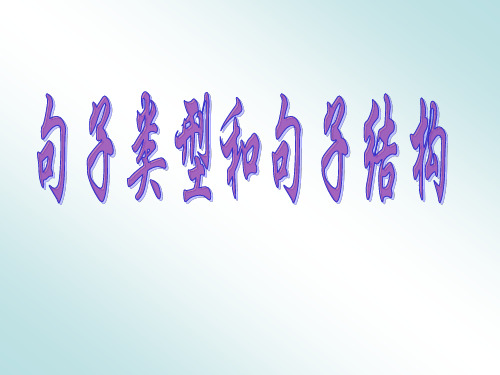
五、基本句型的转换与扩大 1. 基本句型: 陈述句、肯定句、主动句 疑问句、否定句、被动句 e.g. My name is Li Hua. Everyone laughed. The children are sleeping. He asked a question. My friend gave me a book. Tom painted the wall creamy white.
二、句型结构 谓语 主语 Harry is the most handsome boy in our class. All the men have done their best. Mr. Carter will investigate further. Her paintings were judged inferior to Linda’s. Smoking causes trouble in the lungs. e.g. The boys and the girls are listening carefully. I opened the magazine and began to read it.
一、句子种类
1. 完全句和不完全句 完全句:至少有一个完整主谓结构的句子。 不完全句:省略句或独立使用并具有一定 交际功能的句子。 e.g. ----What’s your name? ----Li Hua. No smoking! Help!
2. 简单句、并列句、复杂句、并列复杂句
简单句:只包含一个主谓结构而且各个成分均由词 组构成的句子。
有些及物动词的宾语后需要 5.宾语补足语: 添加部分对宾语进行补充说 明,这一部分称为宾补。 e.g. I found the book very interesting. He made himself known to them first. She asked me to lend her a hand. I consider him as my best friend. We should keep it a secret. Please make yourself at home. 宾语补足语主要由名词、形容词、介词短语、 不定式、V-ing形式或V-ed形式等担任。
句子成分

He has lived in the city for ten years.(介 词短语)
How about meeting again at six?(时间状 语)
Mr Smith lives on the third floor.(地点状 语)
判断下列句子否正确?
1. I’d be glad that if you could come. 2.It was about noon we arrived at the foot of the
mountain..
3.She has two sons , one of them is a doctor. 4. I invited Mike , he promised to go camping
4. My son decided to take them to the little house next door _____ an elderly woman lived by herself and didn’t seem to have much company 。
填谓语还是…?)
1. I suggest we ___ _____(take) a tent as well. 2. When ______(plant) a bunch of flowers one
5. What he said at the meeting is very important,
• 英语五大基本句型如下:
1. S V
(主+谓)
2. S V O (主+谓+宾)
3. S V P (主+系+表)
4. S V o O (主+谓+间宾+直宾)
句子成分和五种基本句型
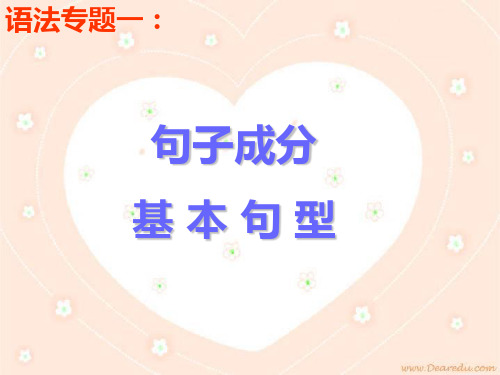
Exercises:
1.Don’t leave the water______ while you brush your teeth. (2004年天津) A. run B. running C. being run D. to run 2. You should understand the traffic rule by now. You’ve had it______ often enough. (2005年天津) A. explaining B. to explain C. explain D. explained
三、祈使句: Be sure to get here before nine. You do it right now. 四、感叹句: ① what + 感叹句: What a noble-hearted man he was! What good news it is! ② how + 感叹句: How well she dances! How fast they are working!
They found her happy that day.
2.主语+不及物动词 来自 S + Vi. )The telephone rang. His father might have died. We all breathe, drink and eat.
注:这种结构中的谓语动词是不及物动词,状语并非结构 上不可缺少的成分。但在某种情况下,不加状语便不能表 达完整的意思,这就引出了下列句型:
A great deal of water is used by people in that city. (被动语态)
She is reading a novel. You may have seen each other. He is doing morning exercises. This factory makes machine tools. Mary has ordered a new dress. I have had my lunch. 注:这种结构中的谓语动词是及物动词,后面只跟一个宾语,因 此称单宾及物动词,一般不需状语即可表达完整的意思。但在某些 情况下,状语必不可少,这就引出了下列句型: △ 主语 + 谓语 + 宾语 + 状语: He put the vase on the table. Jim brought his suitcases upstairs. I’ll take Mary to the station. They treated him kindly.
句子成分及句子种类

主语/宾语/表语/同位从句注意事项: 引导词、语序、语态。
(2)定语从句 引导词的选用取决于:
1)先行词; 2)先行词的修饰语; 3)引导词在定语从句中的成分。 注意:定语从句中的主谓一致;
(3) 状语从句 即用作状语的分句,可作下列状语:
1) 时间 after, before, as, when, while, since, till, until, whenever, as soon as; the moment, every/ each time, next time; no sooner…than, hardly/scarcely…when
Oh, my god!
感叹词
Come in, Mr Green. 呼语
This , I think, is the best way to help them. 插入语
句 子 种 类
种类 用途 例句
用来说明事物或 陈述句 说话人的看法
疑问句 用来提出问题 用来表示请求、 祈使句 命令 用来表达强烈 感叹句 的感情
(七) 补语
补语用于补充说明其他的句子成分,有 主语补语与宾语补语。
主语补语可以用下面东西来表示: 1.形容词 2.名词 3.动词不定式 4.分词
宾语补语可以用下面东西来表示: 1.名词 2.形容词 3.动词分词 4.动词不定式 5.介词短语或副词
He died young. 他死时很年轻。
She was called Lucy. 她名叫露西。 He was seen to go upstairs. 有人看见他上楼了。
(八) 同位语
同位语指两个或两个以上的词语, 指同一个事物,作为同一个句子成分。 This is my cousin, Helen. 这是我的表妹,海伦。
句子成分知识点

句子成分知识点一、短语短语是由词性相同,或者是一个动词短语加上一个介词短语构成的。
短语在句子中充当名词、动词、形容词或副词的成分。
1. 名词短语:名词短语在句子中充当主语、宾语、表语或定语等成分。
例如:- 主语:读书是一种享受。
- 宾语:我喜欢读书。
- 表语:他的职业是老师。
- 定语:一个漂亮的花园。
2. 动词短语:动词短语在句子中充当谓语,用来表示动作或状态。
例如:- 动作:他正在打篮球。
- 状态:我已经放假了。
3. 形容词短语:形容词短语在句子中充当定语,修饰名词或代词。
例如:- 修饰名词:一本有趣的书。
- 修饰代词:这个故事很有趣。
词等。
例如:- 修饰动词:他慢慢地走过去。
- 修饰形容词:他非常高兴。
- 修饰副词:他跑得非常快。
二、从句从句是句子的一部分,不能独立存在,它在句子中充当名词、形容词或副词的成分。
1. 名词性从句:名词性从句在句子中充当主语、宾语、表语或同位语等成分。
例如:- 主语:去旅游是我最喜欢的事情。
- 宾语:我希望你能成功。
- 表语:重要的是你努力了。
- 同位语:我听说你获得了奖学金。
2. 定语从句:定语从句在句子中充当定语,修饰名词或代词。
例如:- 修饰名词:那本书是我刚买的。
- 修饰代词:你看到的那个人是谁?词等。
例如:- 修饰动词:我会去看电影,如果我有时间。
- 修饰形容词:他很高兴,因为他考试得了好成绩。
- 修饰副词:请把词典放在你可以找到的地方。
三、分词短语分词短语是由分词构成的短语,在句子中充当形容词或副词的成分。
1. 现在分词短语:现在分词短语在句子中充当形容词,修饰名词或代词。
例如:- 修饰名词:一位正在读书的女孩。
- 修饰代词:他看着正在唱歌的女孩。
2. 过去分词短语:过去分词短语在句子中充当形容词,修饰名词或代词。
例如:- 修饰名词:一张被撕破的纸。
- 修饰代词:我看到你写完的文章了。
3. 现在分词短语:现在分词短语在句子中充当副词,修饰动词、形容词或副词等。
- 1、下载文档前请自行甄别文档内容的完整性,平台不提供额外的编辑、内容补充、找答案等附加服务。
- 2、"仅部分预览"的文档,不可在线预览部分如存在完整性等问题,可反馈申请退款(可完整预览的文档不适用该条件!)。
- 3、如文档侵犯您的权益,请联系客服反馈,我们会尽快为您处理(人工客服工作时间:9:00-18:30)。
句子成分& 句子结构一、句子成分句子成分主要包括主语、谓语、表语、宾语、定语、状语和补足语等。
主语和谓语是句子的必需部分;宾语、表语和补足语是句子的必要部分;其他成分如状语和定语,是句子的辅助部分。
有些句子还带有感叹语、插入语,它们在句法上与句子其他成分不存在关系,称为独立成分。
1.主语: 主语是句中动作、行为、性质或状态的主体,是一个句子谈论的主题。
主语可以由名词、代词、数词、动词不定式、动名词、从句等来充当。
Some people can ' t use the computet^作主语)He teaches us English. (代词作主语)Three and five is eight. (数词作主语)To read in bed is bad for your eyes. (不定式作主语)Eating more vegetables is good for us. (动名词短语作主语)That you forgot to tell me the time for the meeting caused me lots of trouble. (从句作主语)(广东)Do you need more time to complete the task?Yes, another ten days ____ enough.A, is B, are C, was D, were2.谓语 : 谓语用来说明主语的行动、动作或所处的状态。
谓语由动词或短语动词充当,一般放在主语之后。
谓语可分为简单谓语和合成谓语。
The boy speaks Japanese. (简单谓语)Don' t get off the busuntil it has stopped. (简单谓语)I can play the baseball. (合成谓语)Our city becomes more beautiful. (合成谓语)3.宾语: 宾语表示动作、行为的对象,由名词、代词、数词、动名词、动词不定式或起名词作用的其他成分充当。
I bought a book. (单宾语,名词)The news surprisedus. (单宾语,代词)He told me the news about it. (双宾语,代词 /名词)A friend lent some money to me. (双宾语,名词 /代词)We consider him an honest boy . (复合宾语)Mr. Wang always makes his classes interesting . (复合宾语)4.表语:表语用来说明主语的特征、属性、状态、身份等,与前面的连系动词一起构成系表结构作复合谓语。
My pen friend is an American boy. (名词)This book isn ' t m代词)He was the first to come to school yesterday. (数词)The man looks strong. (形容词)My father is out. (副词)His job is to clean the school. (动词不定式短语)The dictionary is in the bag. (介词短语)Wasting time is killing yourself. (动名词短语)The trouble is that she has lost his phone number. 从(句)5.定语:定语是用来修饰名词或代词的句子成分,分为前置定语和后置定语两种。
1)前置定语:常用来充当前置定语的有形容词、代词、数词、名词或名词所有格,动词 -ing 形式等。
We had agood time in the park. (adj.)His father is doctor. (pron.)She cut the meat intotwo pieces. (numeral)This is a stone table. (n.)Let ' s put the child in thseleeping bag. (v-ing)2)后置定语: 常用来充当后置定语的有形容词、副词、动词不定式、介词短语、分词短语和从句等。
I have got something interesting to tell every one of you. (Adj.)The treesaround were cut last week. (Adv.)Would do you like something to drink ? (Infinitive)The book on the bed is mine. (Prepositional phrase)The model plane flying in the sky is made by Bill. (Present participle)The woman who stands at the gate is my mother. (Subordinate clause)6.状语:状语常用来修饰动词、形容词、副词或整个句子。
它可以表示时间、地点、程度、原因、目的、结果等。
状语常由副词、介词短语、动词不定式、分词短语、从句等担当。
They are walking in the park.He was looking everywhere for Jane.She wasdeeply moved by the story I told her.I ' m sorrtyo keep you waiting for a long time.He spoke so fastthat I couldn 't hear clearly what he sa.id7.补足语 : 补足语是用来说明主语或宾语的性质、状态等的一种句子成分。
含有宾语补足语的句子变为被动语态时,宾语补足语成了主语补足语。
可以作为补足语的有名词、形容词、副词、介词短语、分词、动词不定式等。
You must keep your bedroom clean.He was once again foundwandering along the street. (现在分词作主语补足语 )His parents made him stay at home. (动词不定式作宾语补足语 )f He was madeto stay at home by his paren ts.(动词不定式作主语补足语 )8.同位语 : 对句子中某一成分作进一步解释、说明,与其在语法上处于同等地位的句子成分即同位语。
同位语常置于被说明的词之后。
同位语由名词、代词、数词、从句等充当。
This is Mr. Zhou, our headmaster .We each have a cellph one now.You may leave it to us two.We are excited about the newsthat we win the match .9.独立成分:在句子中插入一个词或短语,这个词或短语并不和其他成分发生语法关系,此时这个词或短语就是一种独立成分。
独立成分包括称呼语、感叹语、插入语等。
Hurry up, friends , or we ' ll be la称呼语作独立成分)Aha! I ' ve got you right her感叹语作独立成分)By the way , what do you usually do at weekend?(插入语作独立成分)二、句子结构英语句子按照结构可分为简单句、并列句和复合句。
1.简单句:只有一个主语(或并列主语)和一个谓语(或并列谓语)的句子叫简单句判断下列句子属于哪种简单句的基本句型:We walked and laughed.The childre n are play ing.Childre n ofte n sing this song.I don ' t know what to do.My bike is n ew.He became a famous scie ntist.Mr. Wu teaches us English.My father bought me a new camera.We can hear someone playing the violin next door.We can keep it warm.拓展: There +be +主语 + 状语英语中有一个独特的句型叫 there be 结构,该结构表示“某地 /某时存在某人 /某物”There无意义,be是谓语动词,它后面的名词是主语,两者在数上必须保持一致。
句子最后为地点状语或时间状语。
There is a car in front of the house.There are many books in his school bag.2.并列句:并列句是由并列连词 and, but, or, so等把两个或两个以上的简单句连在一起而构成的句子。
并列连词的基本句子结构为:简单句+并列连词 + 简单句。
1)表示并列的并列连词I help her and she helps me.*Both Wendy and Kate are from American.2)表示选择的并列连词The girls can go with us, or they can stay at home.*Either he or she is going to help us.3)表示因果的并列连词The days are short, for it is now December.The boy did his homework carefully, so he never made any mistakes4)表示转折的并列连词It is very good, yet it can be better.He is old but he is in good health.That region has plenty of natural resources while this one has none.3.复合句 : 由一个主句和一个或一个以上的从句构成的句子叫做复合句。
主句为句子的主体,从句不能独立,仅用作句子的一个成分,如主语、宾语、表语、同位语、定语、状语等。
